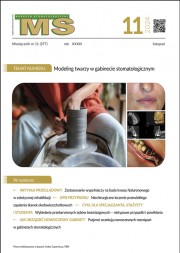Dostęp do tego artykułu jest płatny.
Zapraszamy do zakupu!
Cena: 6.15 PLN (z VAT)
Kup artykuł
Po dokonaniu zakupu artykuł w postaci pliku PDF prześlemy bezpośrednio pod twój adres e-mail.
Treatment of impacted teeth
Jerzy Błaszczak, Agnieszka Skawińska, Maria Mielnik-Błaszczak, Myroslava Drohomyretska
Abstract
Jerzy Błaszczak, Agnieszka Skawińska, Maria Mielnik-Błaszczak, Myroslava Drohomyretska
Streszczenie
Zęby zatrzymane są to zęby całkowicie uformowane, z ukształtowanym i zamkniętym wierzchołkiem korzenia, pozostające w kości lub w tkankach miękkich jamy ustnej po okresie ich fizjologicznego wyrzynania się. Do przyczyn zatrzymania zębów zalicza się między innymi: niekorzystne ułożenie zawiązka zęba, urazy oraz obecność zębów nadliczbowych.
Celem pracy było przedstawienie problematyki zębów zatrzymanych i metod leczenia na podstawie wybranych przypadków klinicznych.
Materiał i metody. Pacjenci leczeni w prywatnym gabinecie. Pacjent, lat 16 – zatrzymany lewy kieł w szczęce. Pacjentka, lat 17 – zatrzymany drugi ząb przedtrzonowy w żuchwie, po stronie prawej. Pacjentka, lat 14 – zatrzymany lewy kieł w szczęce. Pacjent, lat 19 – zatrzymany prawy kieł w szczęce.
Wyniki. Pacjenci zostali poddani chirurgicznemu odsłonięciu zębów zatrzymanych i leczeniu ortodontycznemu.
Wnioski. W leczeniu pacjentów z zatrzymanymi zębami konieczna jest ścisła współpraca ortodonty i chirurga, zarówno w planowaniu leczenia, jak i jego realizacji. Leczenie pacjentów z zatrzymanymi zębami jest trudne, ponieważ niesie ryzyko powikłań. Niezwykle istotnym problemem jest współpraca pacjenta i jego wpływ na przebieg oraz końcowy efekt leczenia.
Wyniki. Pacjenci zostali poddani chirurgicznemu odsłonięciu zębów zatrzymanych i leczeniu ortodontycznemu.
Wnioski. W leczeniu pacjentów z zatrzymanymi zębami konieczna jest ścisła współpraca ortodonty i chirurga, zarówno w planowaniu leczenia, jak i jego realizacji. Leczenie pacjentów z zatrzymanymi zębami jest trudne, ponieważ niesie ryzyko powikłań. Niezwykle istotnym problemem jest współpraca pacjenta i jego wpływ na przebieg oraz końcowy efekt leczenia.
Abstract
Tooth impaction can be defined as the infraosseous position of the tooth after the expected time of eruption. The reasons for retention of teeth includes: unfavorable position of tooth germ, injuries and the presence of supernumerary teeth and othersore.
The aim of the study was to present the issues and methods of treating impacted teeth.
Material and methods. Patients treated in private practice. Patient age 16, detained the left canine tooth in the jaw. Patient age 17, impacted the second premolar in the mandible, right side. Patient age of 14, left canine impacted in the jaw. 19-year-old patient, impacted right canine tooth in the jaw.
Results. The patients underwent surgical exposure of impacted teeth and orthodontic treatment.
Conclusions: In patients with retained teeth a close cooperation of orthodontist and surgeon is very important, both in treatment planning and its implementation. Treatment of retained teeth is difficult because it carries the risk of complications. A very important issue is the cooperation of the patient and his influence on the course and the final effect of the treatment.
Results. The patients underwent surgical exposure of impacted teeth and orthodontic treatment.
Conclusions: In patients with retained teeth a close cooperation of orthodontist and surgeon is very important, both in treatment planning and its implementation. Treatment of retained teeth is difficult because it carries the risk of complications. A very important issue is the cooperation of the patient and his influence on the course and the final effect of the treatment.
Hasła indeksowe: ząb zatrzymany, leczenie ortodontyczne, powikłania
Key words: impacted tooth, orthodontic treatment, complications
PIŚMIENNICTWO
1. Dijakiewicz M., Soroka-Letkiewicz B., Szyck V.: Techniques of surgical exposure of impacted teeth for orthodontic treatment a review. Nowa Stomatol., 2003, 2, 77-79.
2. Kawala B., Szeląg J.: Complex orthodontic-surgical treatment in atypical cases of impacted teeth. Dent. Med. Probl., 2003, 40, 355-362.
3. Guideline on Management Considerations for Pediatric Oral Surgery and Oral Pathology. AAPD, 2015.
4. Paradowska-Stolarz A., Rzepecka-Skupień M., Chojnowski S. i wsp.: Postępowanie ortodontyczne i ortodontyczno-chirurgiczne z kłami zatrzymanymi – przegląd piśmiennictwa. Dent. Forum, 2014, 2, 43-50.
5. Conley R.S., Boyd S.B., Legan H.L. i wsp.: Treatment of a patient with multiple impacted teeth. Angle Orthod., 2007, 77, 4, 735-741.
6. Patel S., Dawood A., Wilson R. i wsp.: The detection and management of root resorption lesions using intraoral radiography and cone beam computed tomography – an in vivo investigation. Int. Endod. J., 2009, 42, 831-838.
7. Baart J.A.: Therapeutic strategies for impacted maxillary canines. Ned. Tijdschr. Tandheelkd., 2000, 107, 90-93.
8. Kokich V.G.: Preorthodontic uncovering and autonomous eruption of palatally impacted maxillary canines. Semin. Orthod., 2010, 16, 3, 205-211.
9. Chapokas A.R., Almas K., Schincaglia G.P.: The impacted maxillary canine: a proposed classification for surgical exposure. Oral Surg. Oral Med. Oral Pathol. Oral Radiol., 2012, 113, 2, 222-228.
10. Sumitra G.: Orthodontic-surgical treatment of bilateral maxillary canine impaction. Contemp. Clin. Dent., 2012, 3, 3, 363-366.
PIŚMIENNICTWO
1. Dijakiewicz M., Soroka-Letkiewicz B., Szyck V.: Techniques of surgical exposure of impacted teeth for orthodontic treatment a review. Nowa Stomatol., 2003, 2, 77-79.
2. Kawala B., Szeląg J.: Complex orthodontic-surgical treatment in atypical cases of impacted teeth. Dent. Med. Probl., 2003, 40, 355-362.
3. Guideline on Management Considerations for Pediatric Oral Surgery and Oral Pathology. AAPD, 2015.
4. Paradowska-Stolarz A., Rzepecka-Skupień M., Chojnowski S. i wsp.: Postępowanie ortodontyczne i ortodontyczno-chirurgiczne z kłami zatrzymanymi – przegląd piśmiennictwa. Dent. Forum, 2014, 2, 43-50.
5. Conley R.S., Boyd S.B., Legan H.L. i wsp.: Treatment of a patient with multiple impacted teeth. Angle Orthod., 2007, 77, 4, 735-741.
6. Patel S., Dawood A., Wilson R. i wsp.: The detection and management of root resorption lesions using intraoral radiography and cone beam computed tomography – an in vivo investigation. Int. Endod. J., 2009, 42, 831-838.
7. Baart J.A.: Therapeutic strategies for impacted maxillary canines. Ned. Tijdschr. Tandheelkd., 2000, 107, 90-93.
8. Kokich V.G.: Preorthodontic uncovering and autonomous eruption of palatally impacted maxillary canines. Semin. Orthod., 2010, 16, 3, 205-211.
9. Chapokas A.R., Almas K., Schincaglia G.P.: The impacted maxillary canine: a proposed classification for surgical exposure. Oral Surg. Oral Med. Oral Pathol. Oral Radiol., 2012, 113, 2, 222-228.
10. Sumitra G.: Orthodontic-surgical treatment of bilateral maxillary canine impaction. Contemp. Clin. Dent., 2012, 3, 3, 363-366.













